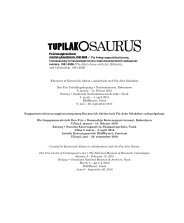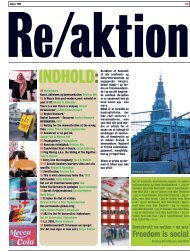tupilakosaurus - Print matters!
tupilakosaurus - Print matters!
tupilakosaurus - Print matters!
Create successful ePaper yourself
Turn your PDF publications into a flip-book with our unique Google optimized e-Paper software.
Arke’s Issue with Art, Ethnicity, and<br />
Colonialism, 1981-2006 is the first<br />
ever comprehensive presentation of<br />
the artist.<br />
Getting to grips with Arke’s work<br />
is no easy matter. In the first place<br />
the work and its organisation were<br />
interrupted by her all too early death,<br />
and there are more “holes” than<br />
main works. Secondly, we who try to<br />
embrace, read and arrange her work<br />
are on the wrong side of the fence, so<br />
to speak. The members of Kuratorisk<br />
Aktion are Danish, white, academics<br />
and curators, that is, people who<br />
administer something that belongs to<br />
someone else.<br />
But if Arke’s investigations show<br />
(as we think they do) that nothing<br />
is faultless, pure or unmixed, then<br />
neither is the postcolonial something<br />
that concerns only those who have<br />
been colonised and are now allegedly<br />
no longer so. It is essentially also<br />
something that concerns all of us<br />
who have been formed by the colonial<br />
powers and the metropoles. We are all<br />
in the mix.<br />
It is precisely this circumstance that<br />
we wish to highlight through our<br />
choice of the exhibition title, TUPILA-<br />
KOSAURUS. Arke herself used the<br />
designation for one of her key works<br />
from 1999, in which she humorously<br />
explores those who explore Greenland<br />
and pushed herself in between<br />
“tupilak” and “saurus”, between myth<br />
and science, to occupy the place of the<br />
“o” in the middle of the word.<br />
Like the title, the structure of the exhibition<br />
reflects that we have allowed<br />
Arke’s investigations to operate on us,<br />
and that we have sought to subject<br />
our research, registration and classification<br />
processes to her method of<br />
analysis. Firstly, we have divided the<br />
exhibition into two parts and show<br />
her works not only in the space of art,<br />
but also in the space of ethnography,<br />
according to the two main fields in<br />
and with which Arke worked. Then,<br />
we have not tried (or perhaps more<br />
accurately: have tried not) to arrange<br />
the material in any irreversible,<br />
over-view-giving or exhaustive way.<br />
Instead we have engaged with the<br />
in every way overwhelming material<br />
that exists by and around Arke<br />
and endeavoured to create thematic<br />
spaces for cross-readings and polyphony<br />
in a wish to keep her work<br />
open for those who want to follow up<br />
on her themes and methods.<br />
Thus, the first theme section of<br />
TUPILAKOSAURUS, Towards a<br />
Historical Narrative, opens with “an<br />
organised disorder” – a picture of<br />
our work to make head or tail of the<br />
copious, scattered material that Arke<br />
left behind. By showing the sight that<br />
met us when we began our work of research<br />
and registration, and thereby<br />
visualising the premises and process<br />
for and of that work, a basis has been<br />
created for outlining in the same<br />
section the first actual theses on the<br />
interplay between personal, scientific<br />
and artistic problematics that gave<br />
form to Arke’s practice. These initial<br />
theses are subsequently investigated<br />
in depth in the eight theme sections:<br />
Tupilakosaurus, Arctic Hysteria,<br />
“Ethno-Aesthetics”, Stories from<br />
Scoresbysund and Legend (first at<br />
Den Frie Centre of Contemporary Art<br />
in Copenhagen and then in Katuaq<br />
in Nuuk) and Fishing out skulls and<br />
bones, the film programme The Eccentric<br />
Eskimo and finally Scandinavian<br />
Panorama (first at the National<br />
Museum in Copenhagen and then at<br />
the Greenland National Museum &<br />
Archives in Nuuk).<br />
All the theme sections derive their titles<br />
and themes from the works Arke<br />
left behind. However, they represent<br />
not only themes in her practice, but<br />
also interpretative approaches that<br />
had already in her lifetime been identified<br />
by insightful people in her professional<br />
and social networks. Among<br />
others these include artists, writers,<br />
critics and filmmakers who value<br />
Arke’s legacy and who besides having<br />
inspired the theme sections with their<br />
interpretations have also contributed<br />
to this TUPILAKOSAURUS guide – a<br />
free publication containing analytic<br />
texts on the works along with factual<br />
information about Arke and her work.<br />
In addition to the guide – and of the<br />
greatest importance for the project<br />
– both Arke’s books, Etno-Aesthetics<br />
(1995) and Stories from Scoresbysund:<br />
Photographs, Colonisation and<br />
Mapping (2003), are being published<br />
in new trilingual editions (English,<br />
Greenlandic and Danish), whereby<br />
they have become accessible once<br />
more for a Danish readership and for<br />
the first time for a Greenlandic and<br />
international public.<br />
Neither with these works, which<br />
have long been out of print, nor with<br />
those of Arke’s works that have<br />
disappeared have we wished to make<br />
faithful copies of the originals. The<br />
books have, as already mentioned,<br />
been transformed into international<br />
editions. And of the many works that<br />
Arke, in accordance with her laidback<br />
work concept chose to dissolve once<br />
more, we have decided to represent<br />
some through pictorial documentation,<br />
while we have chosen to recreate<br />
others because a “recipe” existed.<br />
Finally, TUPILAKOSAURUS is<br />
accompanied by a number of supplementary<br />
albeit independent events:<br />
an international and more theoretical<br />
seminar in Copenhagen, a community<br />
meeting for the general public in Nuuk<br />
and film discussion days in both places.<br />
After the exhibition has been shown in<br />
Copenhagen and Nuuk, it will be taken<br />
over by BildMuseet in Umeå, Sweden,<br />
where its travels will end. Finally, the<br />
exhibition, the TUPILAKOSAURUS<br />
guide and all papers and contributions<br />
from the public events will form<br />
the cornerstone in the coming work<br />
to make and publish a comprehensive<br />
catalogue raisonné of Arke’s unique<br />
oeuvre at the beginning of 2011.<br />
With this project and its individual<br />
parts it is our hope that Pia Arke will<br />
acquire the place both in the history<br />
of art and on the political agenda that<br />
her work so much deserves. Neither<br />
Greenland nor Denmark, whose<br />
relations have moved into a decisive<br />
new phase with the entry into force of<br />
Greenlandic Self-Government on June<br />
21, 2009, can do without her. Nor for<br />
that matter can the world.<br />
11




